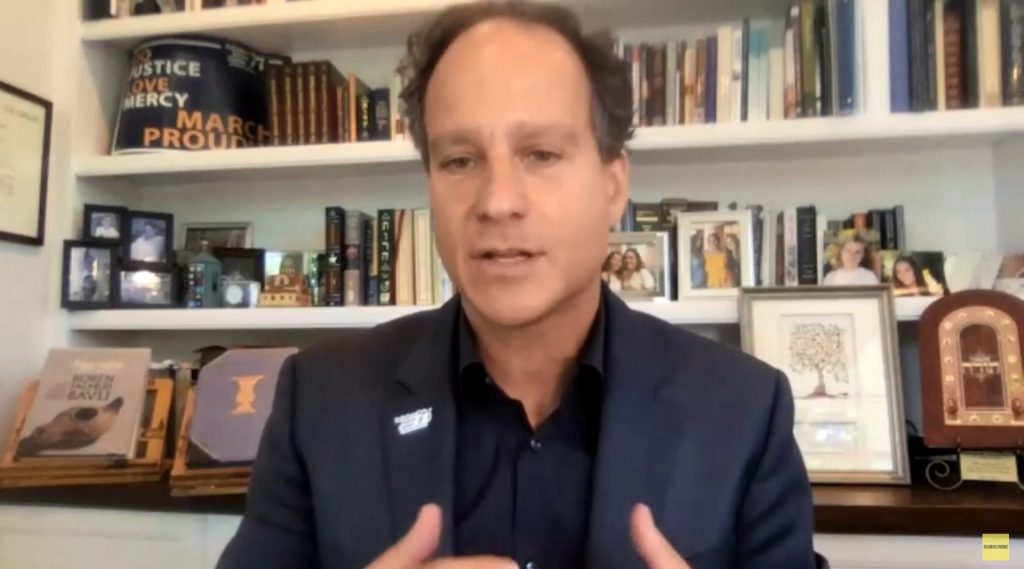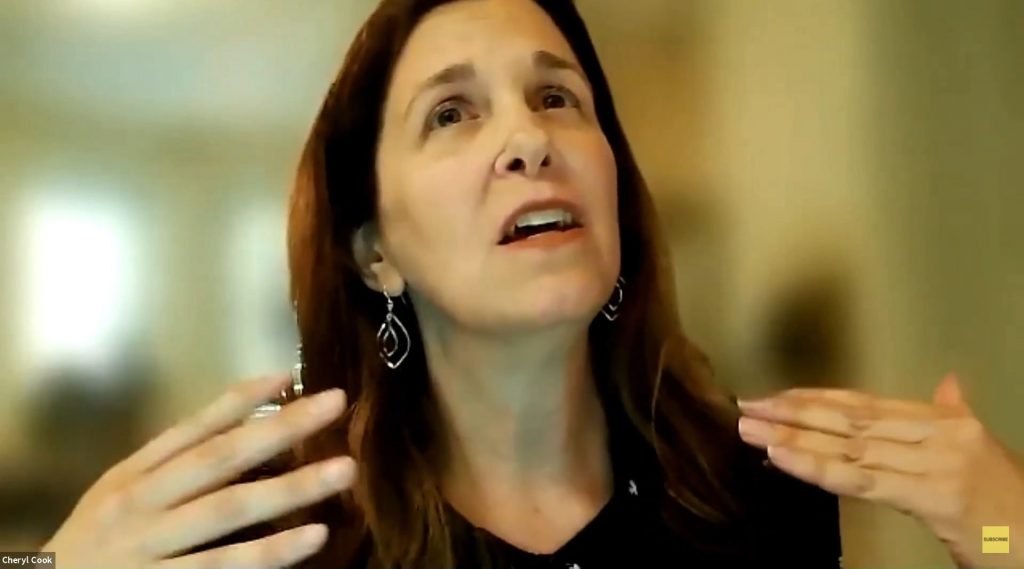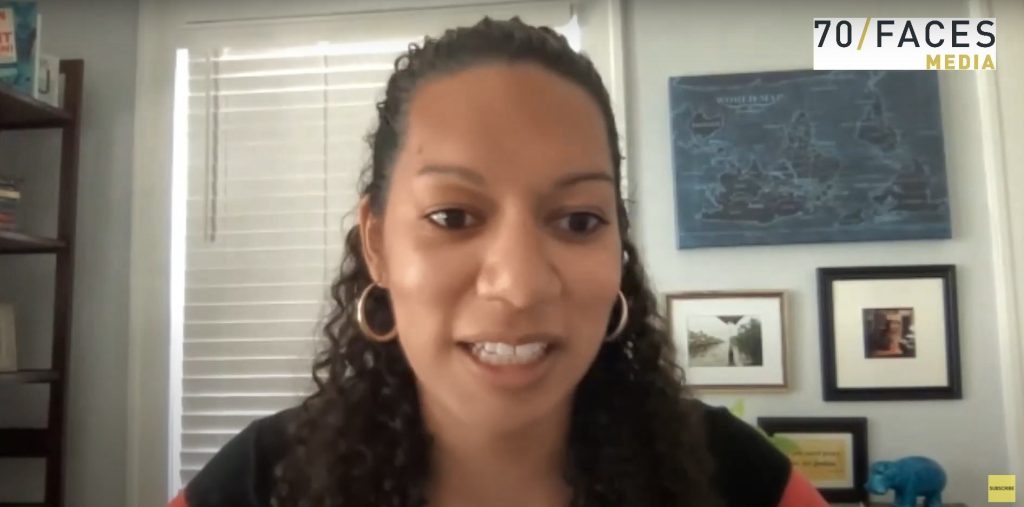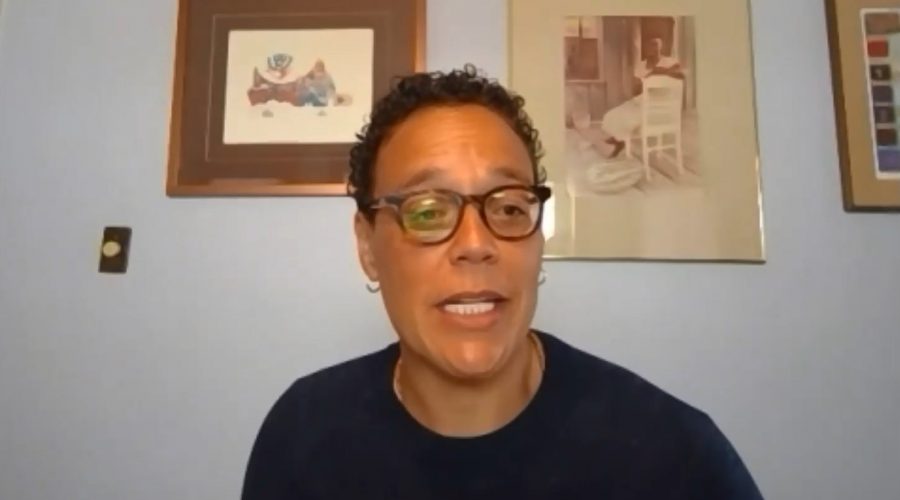Jews need to do better if they’re to get serious about fighting racism, activists say
Published June 28, 2021
The conversation below was adapted from a recent online panel, “The Jewish Imperative to Pursue Racial and Economic Justice,” sponsored by The Genesis Prize and hosted by 70 Faces Media, JTA’s parent organization. The discussion featured leaders of three of the 10 grantees of the initiative for racial and economic justice launched by the 2021 Genesis Prize laureate, film director Steven Spielberg.
The event can be viewed in its entirety in the video embedded in this article.
Megan Black, Common Good program director at Western States Center (moderator)
Each one of us comes to this conversation on race, racial justice, Jewish identity and the American Jewish community from very different places.
I grew up in a Catholic bubble in the Midwest and got into the world of faith-based community organizing and racial justice organizing predominantly with Christian clergy. In 2017, I was at an interfaith racial justice event that I had helped plan and design deliberately to be multifaith and inclusive. We thought it was going great and then I got pulled aside by a group of rabbis who said, “Hey, we’ve got a problem. Y’all don’t really understand antisemitism, and it’s really rearing its head in this space.”
So I started a long journey of being in a relationship with these rabbis and other organizers across the racial, religious and ethnic spectrum, trying to understand how the Jewish community fits into the world of racial justice, what we make of antisemitism and forces like Christian dominance, nationalism and hegemony, and how we understand things like white supremacism. More and more, I see it as a critical piece of the work of racial justice in this country.
Cheryl Cook, executive director of Avodah, the Jewish service corps
My parents grew up in all-Jewish neighborhoods in Detroit. As Jews, my grandparents were red-lined and could only buy in certain areas. But at some point that changed, and Jews who were white were suddenly seen as white and given opportunities. My parents loved the city of Detroit. They stayed put as many in the Jewish community left for the suburbs. They stayed after the civil unrest in 1967. They stayed until they found out they were pregnant with me. I was born in 1969. By then the center of the Jewish community had shifted, and they moved to the suburbs. But even after the left they stayed connected to the city. My dad would take me into Detroit every few weeks to meet with ministers who took over what were synagogues. We’d go see the houses where my parents had grown up and talk to the people who had moved in and their neighbors. So my parents really infused in me this need to be in relationship with people in my community, to understand we’re all part of the same humanity. That really has infused my desire to do this work.
Rabbi Jonah Dov Pesner, director of the Religious Action Center of Reform Judaism
I grew up in a wonderful Reform synagogue in lower Manhattan. It was the center of my life. My dad was the temple president. It was a warm, nurturing, loving bubble. Tragedy struck when I was entering high school: My father died very suddenly. Two things happened. The Jewish community surrounded me with love. And my mother became a single, working mom. We lived in affordable housing, and I left the private school system and went to public school. I wound up at the best school in New York City, Bronx Science, and took the No. 4 train every day from Union Square to 205th Street. God put me on that train for a reason. I was very often the only shrimpy, white Jewish kid in all Black and Brown environments. The New York of the early 1980s was devastated. It was a community that had been abandoned, and human beings were suffering in reprehensible poverty and despair. Law enforcement just turned their backs.
I found a grinding disconnect between the articulated values of my synagogue, what my rabbis preached, and what the Reform Jewish movement said it stood for, and the utter abandonment of the human beings I saw living in the South Bronx, some of whom were on my train and then next to me in math class. I devoted my rabbinate to challenging the Jewish community to act on its 5,000-year-old set of values contained in our sacred scriptures and rabbinic wisdom.

“In what ways are we complicit with white supremacy in the synagogue?” says Rabbi Jonah Pesner, director of the Religious Action Center of Reform Judaism, in a panel on racial justice, June 23, 2021. (JTA)
Ilana Kaufman, executive director of the Jews of Color Initiative
I grew up in San Francisco. I was born in 1972 — the edge of the Vietnam War, the Black Power movement, the civil rights movement. I didn’t know there weren’t Black Jewish people until I went to synagogue. In a community of 2,000 people, there were only five people of color. Anytime we asked why there weren’t more people who looked like us I was met with confusion, as if the entire container and paradigm in which the U.S. Jewish world exists only understood itself as white.
Fast forward to my work in the Jews of Color Initiative. How could the U.S. Jewish community not be multiracial and multiethnic in a context where the entire physics of the United States is to be multiracial? What is it that made us think of ourselves and operate as all-white in a context where the science and the data tells us that’s impossible? There have been Jews of color in the United States since the 1600s. In the late 1600s and 1700s, 10% of the U.S. Jewish community were people of color.
What’s the role of racism in participating in this myth of whiteness, and its cost? What’s at stake for the U.S. Jewish community? We are already somewhere between 8-15% people of color. We’re only 2% of the U.S. population. Twenty percent of our families are multiracial, and every day those numbers get bigger. Something like 20% of our young people ages 0-18 are nonwhite.
This is not an intellectual exercise. This is not about when will we be multiracial. This is about when will we realize ourselves as multiracial? When we get there, exciting things happen. We get to understand what it means to be in our power as a multiracial Jewish community, what it means to coalesce around this power and then be in relationship with other movement partners, what it means to commingle in a context where we collectively have these goals of anti-racism.
Black: I do a lot of training on racial justice with congregations, and I always do a session on the story of race in this country — the story we’ve been told and the one we’ve been uncovering and rewriting. It seems there’s an existing story about race and racial justice in the American Jewish community. From your perspective, what’s the narrative shift that needs to happen?
Kaufman: For many people in the United States who are both Ashkenazi and Jewish, the container has been us running from antisemitism, finding ways to keep ourselves safe — which is vital in a context where antisemitism will always exist. (That’s why we need to be a movement of partnership with other people.) In this container, we have created a self-fulfilling context where when we project everybody who we think are U.S. Jews as white, we then begin to believe the narrative that Jews are white. It’s really important when we study U.S. history to understand that for people who are white to ascend in the United States — because people from Irish descent, Armenians, Greeks, Italians were not considered white — there was a choice people had to make to participate in moving into whiteness. Part of that choice was about protecting Jews and giving Jews the tools to become self-sufficient and ascend in the U.S. Jewish community.
But there was a cost to that choice. That cost was that those tools of privilege and ascension were not offered to Black and Brown people. When we separate ourselves from Black and Brown people, not realizing that we ourselves are Black and Brown people, we both then accept those tools of whiteness and power and privilege, and there’s a cost. Until we understand the choices we’ve made and the cost and make repair for that, it gets in the way of us progressing as a national community.
Cook: The story in Detroit of white Jews moving out was replicated in cities across our country. What happened was Black and Brown people who were looking for opportunity were suddenly allowed to move into neighborhoods that were Jewish, and then real estate brokers started knocking on doors and saying, “Your house is about to lose value and you’ve got to move,” and people took the bait. It’s a moment in our Jewish history that we have to reflect on and hold and do some teshuvah for. It is a sad moment in our history when many Jewish communities abandoned cities or neighborhoods because of fear.
We have to see ourselves as multicultural and multiethnic. Understanding our history and telling that story differently than we’ve told it before is a huge part of being able to rebuild who we are now.

“It is a sad moment in our history when many Jewish communities abandoned cities or neighborhoods because of fear,” says Cheryl Cook, executive director of Avodah, the Jewish service corps, reflecting on urban Jewish flight to the suburbs in the 1960s and ’70s. (JTA)
Pesner: More than 2 million people call themselves Reform Jews. If you look carefully at the data that Ilana has brought forward, on the one hand we’re the largest and most diverse denomination in Jewish life. On the other hand, we do not reflect the multiracial reality of the United States of America. Ilana, in a very good, agitational moment, once challenged me a few years ago and said, “If the Reform Jewish movement is so inclusive of interfaith families, let’s say, if so many LGBTQIA folks have found a home in Reform Judaism, why are Black and Brown Jews not finding a home in the Reform Jewish movement? It’s racism.”
It’s hard as a white Jewish liberal to acknowledge that maybe we do have a racism problem. When the kid finishes his bar mitzvah and comes off the bimah and is handed a tray to serve because he looks more like Ilana than me, that’s racism. Or the vice president of a synagogue who comes every week and is then “welcomed” by greeters who rotate once a year and say, “What brings you here tonight?” And she says, “I’m the vice president of the synagogue and you are interrogating me because I don’t look like you.” We have a racism problem.
For those of us who, like me, are white Jews, this journey has been about lots of “cheshbon nefesh,” an accounting for the soul, and the teshuvah that Cheryl described, to ask: In what ways are we complicit with white supremacy in the synagogue, and in the structural dynamics that lead to a community that does not look like or act like what it says its values are?
There’s a beautiful theological imperative in an incredible midrash that says God created the first human out of white sand and black loam and yellow clay and all the colors of the earth so that we would know the theological imperative that no human who looks different or is different in color is different than others. And yet we’ve allowed white supremacy to seep into who we are.
Black: I’m hearing from you that there’s a need for a reckoning, and about the tension between the values you learned in the synagogue and what you saw in the world. Do we see the reckoning happening yet? What might it look like? If racial justice is a Jewish value, why haven’t we yet dealt with our racism?
Kaufman: I’m trained as a classroom teacher. As a teacher, I don’t get it. I don’t get why we in the U.S. as a Jewish community haven’t stepped back. We were all designed to have the capacity to recognize and hold difference and racial difference. As part of the U.S. community, we also have been designed to not only participate in racism but to benefit from it, to oppress other people.
I don’t think we should get so excited or agitated by the fact that we all participate and foment and perpetuate racism. We live in the U.S. That is the air we breathe. That has been what we’ve been designed to do, and that is how we are set up to succeed and fail. I want to get excited by the fact that we know this, we’re aware of it, and we have the tools and capacity as Jews to respond to these problems — through content, value and Torah, through being smart folks who are great problem solvers, through being people who care about equity, justice and change.
As a Jewish community we have to understand what will it mean to give up some privilege. These are privileges that have been unearned. They have been assigned to folks because of how they’re perceived. What does it mean to create space in the U.S. Jewish community for folks who are part of communities of color, and how do we do that in a way that’s authentic? I don’t worry about the Jewish community being diluted. We’ve survived more than 5,000 years in all our iterations. We will be fine. But if we don’t get this part right, it means that klal Yisrael domestically will fail.
Pesner: Black Lives Matter is a Jewish value. Part of the problem is that white supremacy tries to divide communities when people have experienced oppression and been marginalized. One of the tools is to pit the white Jewish community that’s afraid of the antisemitism — which is real, it’s been violent of late — and then use that as a weapon to pit us against other marginalized communities. For those who are Black and Brown in the Jewish community, for LGBTQIA Jews, for disabled Jews and so many other marginalized communities, that is not an option.
We must ask the question: To what extent does my fear or own internalized racism allow me to become weaponized? Another example is critical race theory. There are forces in the Jewish community that are suddenly using, for partisan political purposes, this really important way of thinking about the universe that actually centers the experience of Black Americans, the descendants of African slaves, and what the systems of racism for 400 years have led us to, which just asks us to have an honest accounting. But then suddenly that gets weaponized, and against the Jewish community in particular, to say to the white Jewish community: “Choose. Are you on this side or that side?” It feels anti-Jewish to me and anti-intellectual.

“There is a narrative about antisemitism that is deeply misunderstood, and that is a real threat not just to the Jewish community, but more broadly to my own black American community,” says Megan Black, Common Good program director at Western States Center. (JTA)
Black: I used to focus on organizing around criminal justice reform, immigration reforms. But it became clearer to me that there is a narrative about antisemitism that is deeply misunderstood, and that is a real threat not just to the Jewish community, but more broadly to my own Black American community. The fact that it’s misunderstood makes it easy to become weaponized and a force of division. I’m very curious about the ongoing conversation that needs to happen about how we understand antisemitism in the context of white supremacy. What is the conversation about antisemitism that you want to be having right now?
Cook: Antisemitism is used by the powerful to distract: “It’s the Jews.” We’re scapegoated. “It’s the Jews who are controlling the world.” All those tropes of antisemitism are used to distract about what’s going on. That’s important for us to talk about because we don’t want to keep propping up white supremacy. We want to understand the difference between antisemitism and racism. Racism is used to benefit or oppress groups, which is different than antisemitism, which is used to scapegoat. You get a little bit of privilege and then you sit in that privilege and hold up the power.
My nephew is Black and Jewish. We have so many Black Jews, especially in the younger generation. We have people who are living with both and are thought leaders to help us take apart and build up some of the blind spots I’ve had as a white Jew who grew up in this country.
Kaufman: Understanding and responding to antisemitism has to be taught, the same way we teach anti-racism, anti-homophobia and being open to people with different abilities. These are literacies that we need to have. In the American Jewish community we overestimate how much people know about Jews, Judaism, Israel, Jewish identity. Why would anybody know anything? When you think about the public school system and what people are learning — 95% of Americans go to public schools — where would we learns about Jews, Judaism and Israel?
How do we teach these themes for young people? And how do we do it in a way that understands that young people come from backgrounds that, in order to understand the experience of Jews, they have to understand their own backgrounds? Because their families fled from places, too. Their families experienced genocide, too. Their families experienced indentured servitude and slave labor, too.
Other peoples’ stories are important, too. This is not a competition. We cannot create a structure where people are in competition to understand antisemitism. My daughter who is 15 1/2 deserves to know her history as a Jewish person, as a Black person, as a woman. She can hold all of that, and it makes her understand antisemitism better. How do we do that for everybody, so that everybody understands antisemitism not at the cost of understanding their own identity, but in a way that elevates everybody’s understanding and builds community?
Black: Let’s talk a little about Jewish philanthropy. What are you excited about and where does more work need to happen?
Pesner: There was a big push over the last 18 months because of the crisis. The funding community came in and said, “We need to give emergency help” and wanted to do some catalytic, transformational investments. I was surprised by the number of those funders who, when I said, “And we need to double down on racial justice, equity and inclusion in the Jewish community because that is the single biggest challenge, that is the unreconciled business of the Jewish community today” – they looked at me with a blank stare and said, “Oh, that’s our racial and equity portfolio, which is that pocket of money over there.”
Really!? If Ilana’s right in laying out the huge gap between what the Jewish community looks like and the multiracial reality and our values, why wouldn’t we do a Marshall Plan about confronting racism and injustice within the synagogue? It might actually transform synagogues and Jewish education to be compelling, joyful places kids want to be. Because we’d have to say what would actually engage and turn people onto Judaism because they want to be there, they want to belong.
Racism is in the oxygen we breathe as Americans. We must dismantle racism in the synagogue I go to, the town I live in, this state, this country — we’ve got to do it all!
Cook: Five years ago, during the summer of the movement for Black lives, Avodah decided we wanted to do racial justice work internally, and I went to multiple funders asking for about $15,000. Nobody was hearing me. It was really hard. I didn’t raise the money, but I did the work anyway. It felt hard because it wasn’t a priority in our Jewish community. Now I’ve seen a huge sea change. I want to honor that, but I want to push them farther.
When we fill our grant forms nobody asks us about pay equity, about the work we’ve done to move forward racial justice work as an organization. I think the funder community should, and has incredible leverage to help impact organizations on the ground in the Jewish community.
Kaufman: We run the country’s only philanthropic fund focused on Jewish people of color, and we raise that from the community. We try to do everything we do through the lens of equity and racial justice. In the philanthropic community — and particularly in the Jewish space, where there is no accountability (it’s not like all the funders roll up to some organization’s standards of excellence; we only roll up to ourselves) — we have to hold each other accountable to be excellent and have integrity and do righteous work. That means applying lenses of equity and justice to everything we do in the philanthropic and funding community. What would look different if we applied racial justice and equity lenses to our work? How would we make repair for the inequity and injustice that’s been perpetuated for so many decades in our community? What’s been the cost? What is the opportunity, and where do we get to go together?
I’m interested in nudging, having these conversations, talking about accountability, about why our funding portfolios are essentially racially segregated. There’s the community engagement work and then there’s the justice work. But isn’t that the same? If people experienced justice, wouldn’t they be more engaged?
I’m interested in applying these lenses with some rigor, and pushing ourselves to create not only outcomes but accountability for those outcomes.
The post Jews need to do better if they’re to get serious about fighting racism, activists say appeared first on Jewish Telegraphic Agency.














